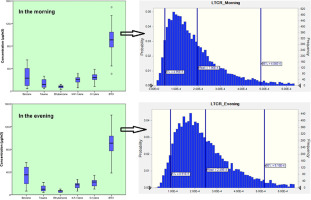Ecotoxicology and Environmental Safety ( IF 6.8 ) Pub Date : 2018-03-03 , DOI: 10.1016/j.ecoenv.2018.02.065 Mansooreh Dehghani , Mehdi Fazlzadeh , Armin Sorooshian , Hamid Reza Tabatabaee , Mohammad Miri , Abbas Norouzian Baghani , Mahdieh Delikhoon , Amir Hossein Mahvi , Majid Rashidi

|
This study reports a spatiotemporal characterization of toluene, benzene, ethylbenzene, and xylenes concentrations (BTEX) in an urban hot spot in Iran, specifically at an bus terminal region in Shiraz. Sampling was carried out according to NIOSH Compendium Method 1501. The inverse distance weighting (IDW) method was applied for spatial mapping. The Monte Carlo simulation technique was applied to evaluate carcinogenic and non-carcinogenic risk owing to BTEX exposure. The highest average BTEX concentrations were observed for benzene in the morning (at 7:00–9:00 A.M. local time) (26.15 ± 17.65 µg/m3) and evening (at 6:00–8:00 P.M. local time) (34.44 ± 15.63 µg/m3). The benzene to toluene ratios in the morning and evening were 2.02 and 3.07, respectively. The main sources of BTEX were gas stations and a municipal solid waste transfer station. The inhalation lifetime cancer risk (LTCR) for benzene in the morning and evening were 1.96 × 10−4 and 2.49 × 10−4, respectively, which exceeds the recommended value by US EPA and WHO. The hazard quotient (HQ) of all these pollutants was less than 1. The results of this work have implications for public health near ‘hot spots’ such as IKBT where large populations are exposed to carcinogenic emissions.
中文翻译:

BTEX在城市污染热点地区的特征及其对健康的影响
这项研究报告了伊朗城市热点地区(特别是设拉子的一个公交终点站)的甲苯,苯,乙苯和二甲苯浓度(BTEX)的时空特征。根据NIOSH纲要方法1501进行采样。逆距离加权(IDW)方法应用于空间映射。蒙特卡罗模拟技术用于评估由于BTEX暴露而致癌和非致癌的风险。在早晨(当地时间7:00–9:00 AM)(26.15±17.65 µg / m 3)和晚上(当地时间6:00–8:00 PM)观察到苯的最高BTEX平均浓度( 34.44±15.63 µg / m 3)。早晨和晚上苯与甲苯的比率分别为2.02和3.07。BTEX的主要来源是加油站和市政固体废物转运站。早晨和晚上苯的终生吸入性癌症风险(LTCR)分别为1.96×10 -4和2.49×10 -4,超过了US EPA和WHO的建议值。所有这些污染物的危害商(HQ)均小于1。这项工作的结果对“热点”(例如IKBT)附近的公共卫生产生了影响,而IKBT则使大量人口暴露于致癌物质。


























 京公网安备 11010802027423号
京公网安备 11010802027423号